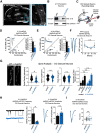Protein 4.1N Plays a Cell Type-Specific Role in Hippocampal Glutamatergic Synapse Regulation
- PMID: 37845032
- PMCID: PMC10711697
- DOI: 10.1523/JNEUROSCI.0185-23.2023
Protein 4.1N Plays a Cell Type-Specific Role in Hippocampal Glutamatergic Synapse Regulation
Abstract
Many glutamatergic synapse proteins contain a 4.1N protein binding domain. However, a role for 4.1N in the regulation of glutamatergic neurotransmission has been controversial. Here, we observe significantly higher expression of protein 4.1N in granule neurons of the dentate gyrus (DG granule neurons) compared with other hippocampal regions. We discover that reducing 4.1N expression in rat DG granule neurons of either sex results in a significant reduction in glutamatergic synapse function that is caused by a decrease in the number of glutamatergic synapses. By contrast, we find reduction of 4.1N expression in hippocampal CA1 pyramidal neurons has no impact on basal glutamatergic neurotransmission. We also find 4.1N's C-terminal domain (CTD) to be nonessential to its role in the regulation of glutamatergic synapses of DG granule neurons. Instead, we show that 4.1N's four-point-one, ezrin, radixin, and moesin (FERM) domain is essential for supporting synaptic AMPA receptor (AMPAR) function in these neurons. Altogether, this work demonstrates a novel, cell type-specific role for protein 4.1N in governing glutamatergic synapse function.SIGNIFICANCE STATEMENT Glutamatergic synapses exhibit immense molecular diversity. In comparison to heavily studied Schaffer collateral, CA1 glutamatergic synapses, significantly less is known about perforant path-dentate gyrus (DG) synapses. Our data demonstrate that compromising 4.1N function in CA1 pyramidal neurons produces no alteration in basal glutamatergic synaptic transmission. However, in DG granule neurons, compromising 4.1N function leads to a significant decrease in the strength of glutamatergic neurotransmission at perforant pathway synapses. Together, our data identifies 4.1N as a cell type-specific regulator of synaptic transmission within the hippocampus and reveals a unique molecular program that governs perforant pathway synapse function.
Keywords: 4.1N; AMPA receptor; dendritic spines; dentate gyrus; synapse.
Copyright © 2023 the authors.
Figures




Similar articles
-
Tiam1 is Critical for Glutamatergic Synapse Structure and Function in the Hippocampus.J Neurosci. 2019 Nov 20;39(47):9306-9315. doi: 10.1523/JNEUROSCI.1566-19.2019. Epub 2019 Oct 9. J Neurosci. 2019. PMID: 31597723 Free PMC article.
-
Chronic Fluoxetine Induces the Enlargement of Perforant Path-Granule Cell Synapses in the Mouse Dentate Gyrus.PLoS One. 2016 Jan 20;11(1):e0147307. doi: 10.1371/journal.pone.0147307. eCollection 2016. PLoS One. 2016. PMID: 26788851 Free PMC article.
-
The Amyloid Precursor Protein Regulates Synaptic Transmission at Medial Perforant Path Synapses.J Neurosci. 2023 Jul 19;43(29):5290-5304. doi: 10.1523/JNEUROSCI.1824-22.2023. Epub 2023 Jun 27. J Neurosci. 2023. PMID: 37369586 Free PMC article.
-
Comparison of cellular mechanisms of long-term depression of synaptic strength at perforant path-granule cell and Schaffer collateral-CA1 synapses.Prog Brain Res. 2007;163:473-500. doi: 10.1016/S0079-6123(07)63026-X. Prog Brain Res. 2007. PMID: 17765734 Review.
-
Understanding the molecular diversity of synapses.Nat Rev Neurosci. 2025 Feb;26(2):65-81. doi: 10.1038/s41583-024-00888-w. Epub 2024 Dec 5. Nat Rev Neurosci. 2025. PMID: 39638892 Review.
References
Publication types
MeSH terms
Grants and funding
LinkOut - more resources
Full Text Sources
Research Materials
Miscellaneous
